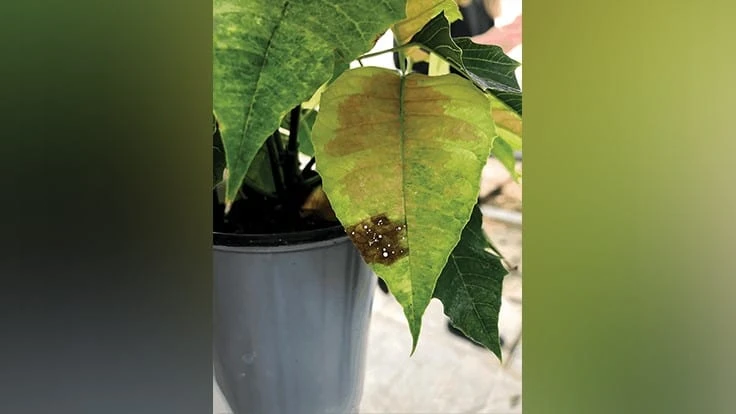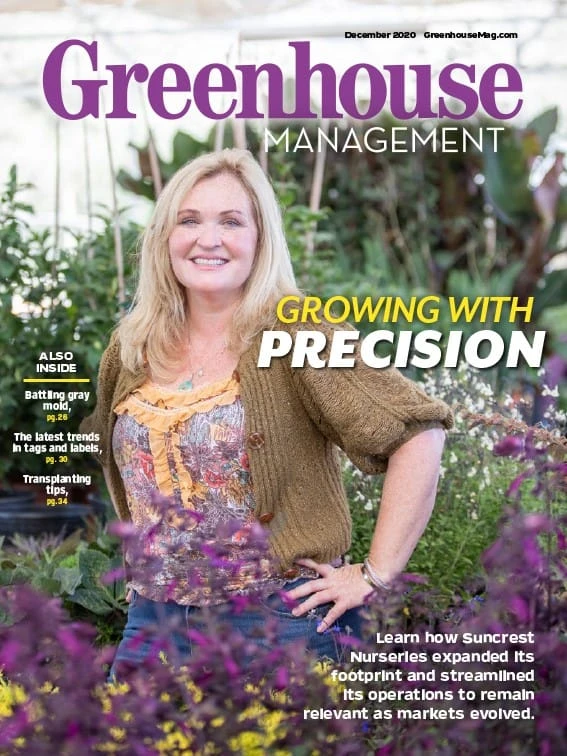

At MSU, Lukasko is evaluating fungicides that can combat gray mold. She says growers must be aware that gray mold can affect that wide variety of crops because assuming it won’t spread from plant to plant is a disaster waiting to happen. Typically, she says that Botrytis only affects plant material that is above ground, such as leaves, petals and sometimes stems. Usually, large brown or tan leaf spots are the most obvious sign of gray mold.
“Botrytis is ubiquitous. Botrytis is everywhere,” Lukasko says. “It’s just a matter of if you have the correct environment that can cause disease. It’s airborne. It can come in on infected plants, possibly from outside the greenhouse. It stays there for a long time because it infects a wide variety of ornamental crops.” This can even be true when growers go from petunias then geraniums and so on if the petunias were infected and not handled properly.
“The cycle can just continue over and over,” she says.
An ongoing fight
Lukasko says that it’s not any one factor that makes Botrytis hard to contain for growers. The combination of every risk factor, she says, makes it something that requires a real plan and focus. It’s a constant effort to scout for it and maintain the proper environmental conditions to prevent it, along with spraying fungicides, she says.
“For a lot of crops, Botrytis can infect at multiple stages. That could be during propagation, during the middle of a crop’s growing cycle and especially at the end. Botrytis favors weak tissue, so that can be, for example, flower petals.”
There are fungicide options for gray mold, Lukasko says. In her research, the only spot-specific fungicide they’ve found that has been 99% resistant is thiophanate-methyl.
“In my current research, that’s the only product I’ve seen have that has a high level of resistance,” she says. “That’s something I would then never recommend to growers for treatment of Botrytis.” Lukasko also notes that once a plant is dead because of gray mold, it needs to be properly disposed of as quickly as possible to prevent any more spread.



Major risk factors
The biggest factors for gray mold, Lukasko says, are a combination of high relative humidity and free moisture. She says that those are “100% necessary” for infection to take place.
Some growers, she says, apply calcium to crops to strengthen the plants. That practice, though, isn’t widely used and has only been studied at Clemson University. More research is needed to verify how effective that is. Lukasko, in fact, is doing research on calcium to better understand its efficacy in preventing gray mold.
“Botrytis favors slightly cooler temperatures and it likes to hide under the overstory of the plants,” she says. “You’re going to see more Botrytis when you have shadier, cooler conditions.” This is true regardless of where a greenhouse is located, Lukasko says.
When plants start growing, Lukasko says it becomes especially important to monitor high relative humidity.
“That can mean using fans to circulate air in the greenhouse,” she says. “That means it’s important to space out plants and avoid dead plant material scattered around the greenhouse. Clean up well and avoid any free-standing water around the greenhouse — anything that’s going to increase humidity needs to be addressed.”
Cleaning is important because dead plant material is a common place for gray mold to find a home and spread around to other plants. Every greenhouse is different in terms of size, type of structure and more. The same applies for temperature and how often fans need to be run.
“As often as you can, but it also depends on the conditions of the greenhouse,” she says. “If your greenhouse is warmer and less humid, then maybe you don’t need to clean as much as someone with a cooler, shaded greenhouse.”

Managing risk as plants get larger
As plants grow, Lukasko says it becomes more and more important to maintain proper spacing between plants. It’s not so much about putting a certain distance between each plant, but more about eliminating contact between plants because that’s where the spread could happen.
“That’s also going to lower humidity because the most humid place on a plant is under the leaves,” she says. “So, if you have the leaves overlapping, you’re creating an environment with high relative humidity.”
“It’s also good, in terms of Botrytis, to keep the top of the soil as dry as possible because oftentimes, that’s where Botrytis starts and it proliferates and it spreads throughout the greenhouse from locations like that,” Lukasko adds. “When you’re scouting, that’s why it’s important to pull back the plants and check the top of the soil.”
And even when plants are fully grown and ready to ship, they are at risk. Gray mold can be a truly on-going concern for growers if they are not careful.
“Any time you are moving plants around in the greenhouse — whether that’s during propagation or when you’re shipping — think of Botrytis as similar to dust,” Lukasko says. “If you’re moving around a plant that’s covered in dust, you’re going to spread the dust around. If you’re moving around a plant with Botrytis, you’re going to spread those spores around. If you’re moving around a lot of plants in the greenhouse, you have to be aware that you might be spreading around a lot of Botrytis spores.”

Explore the December 2020 Issue
Check out more from this issue and find your next story to read.
Latest from Greenhouse Management
- Anthura acquires Bromelia assets from Corn. Bak in Netherlands
- Top 10 stories for National Poinsettia Day
- Langendoen Mechanical hosts open house to showcase new greenhouse build
- Conor Foy joins EHR's national sales team
- Pantone announces its 2026 Color of the Year
- Syngenta granted federal registration for Trefinti nematicide/fungicide in ornamental market
- A legacy of influence
- HILA 2025 video highlights: John Gaydos of Proven Winners





